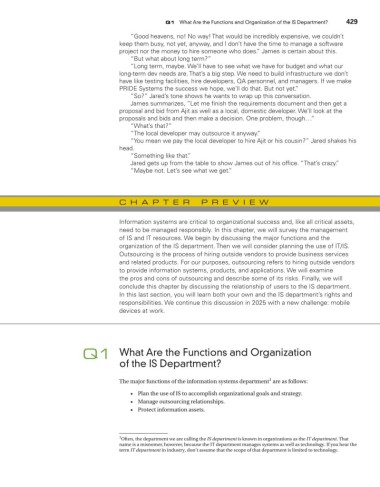Page 461 - Using MIS
P. 461
Q1 What Are the Functions and Organization of the IS Department? 429
“Good heavens, no! No way! That would be incredibly expensive, we couldn’t
keep them busy, not yet, anyway, and I don’t have the time to manage a software
project nor the money to hire someone who does.” James is certain about this.
“But what about long term?”
“Long term, maybe. We’ll have to see what we have for budget and what our
long-term dev needs are. That’s a big step. We need to build infrastructure we don’t
have like testing facilities, hire developers, QA personnel, and managers. If we make
PRIDE Systems the success we hope, we’ll do that. But not yet.”
“So?” Jared’s tone shows he wants to wrap up this conversation.
James summarizes, “Let me finish the requirements document and then get a
proposal and bid from Ajit as well as a local, domestic developer. We’ll look at the
proposals and bids and then make a decision. One problem, though. . .”
“What’s that?”
“The local developer may outsource it anyway.”
“You mean we pay the local developer to hire Ajit or his cousin?” Jared shakes his
head.
“Something like that.”
Jared gets up from the table to show James out of his office. “That’s crazy.”
“Maybe not. Let’s see what we get.”
Chapter preview
Information systems are critical to organizational success and, like all critical assets,
need to be managed responsibly. In this chapter, we will survey the management
of IS and IT resources. We begin by discussing the major functions and the
organization of the IS department. Then we will consider planning the use of IT/IS.
Outsourcing is the process of hiring outside vendors to provide business services
and related products. For our purposes, outsourcing refers to hiring outside vendors
to provide information systems, products, and applications. We will examine
the pros and cons of outsourcing and describe some of its risks. Finally, we will
conclude this chapter by discussing the relationship of users to the IS department.
In this last section, you will learn both your own and the IS department’s rights and
responsibilities. We continue this discussion in 2025 with a new challenge: mobile
devices at work.
Q1 What Are the Functions and Organization
of the IS Department?
1
The major functions of the information systems department are as follows:
• Plan the use of IS to accomplish organizational goals and strategy.
• Manage outsourcing relationships.
• Protect information assets.
1 Often, the department we are calling the IS department is known in organizations as the IT department. That
name is a misnomer, however, because the IT department manages systems as well as technology. If you hear the
term IT department in industry, don’t assume that the scope of that department is limited to technology.

